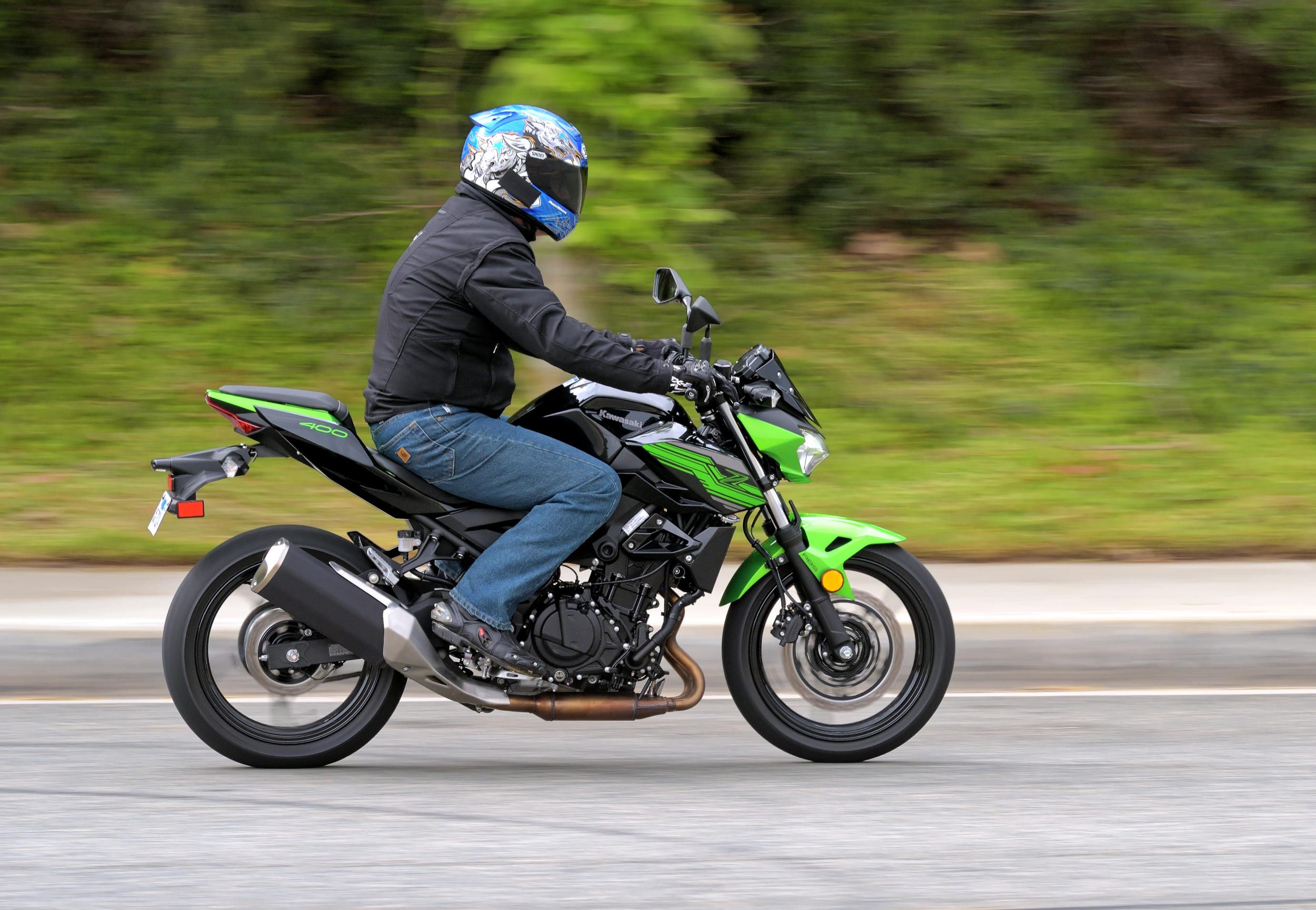
If you read our report from the press launch of the 2019 Kawasaki Z400, you know we were impressed. Not surprising, really, given the fact that the Z400 is very closely related to its sibling the Ninja 400, which was named MD’s BOTY last year.
We won’t bore you with all the details, which can be found in our earlier articles, but here are the highlights. Basically, Kawasaki chose to leave behind the “entry level” street bike category by building a 399cc parallel twin engine with way more power and torque than the 250s/300s, putting that engine in a more capable chassis (larger diameter fork tubes, larger rear tire, and bigger disc brake up front), while keeping the price in line with those entry level models – a U.S. MSRP of $4,799 with standard ABS and LED headlights and tail lights. On paper, this is a very impressive motorcycle … and it kicks ass in the real world beneath anyone from a novice to an expert rider.
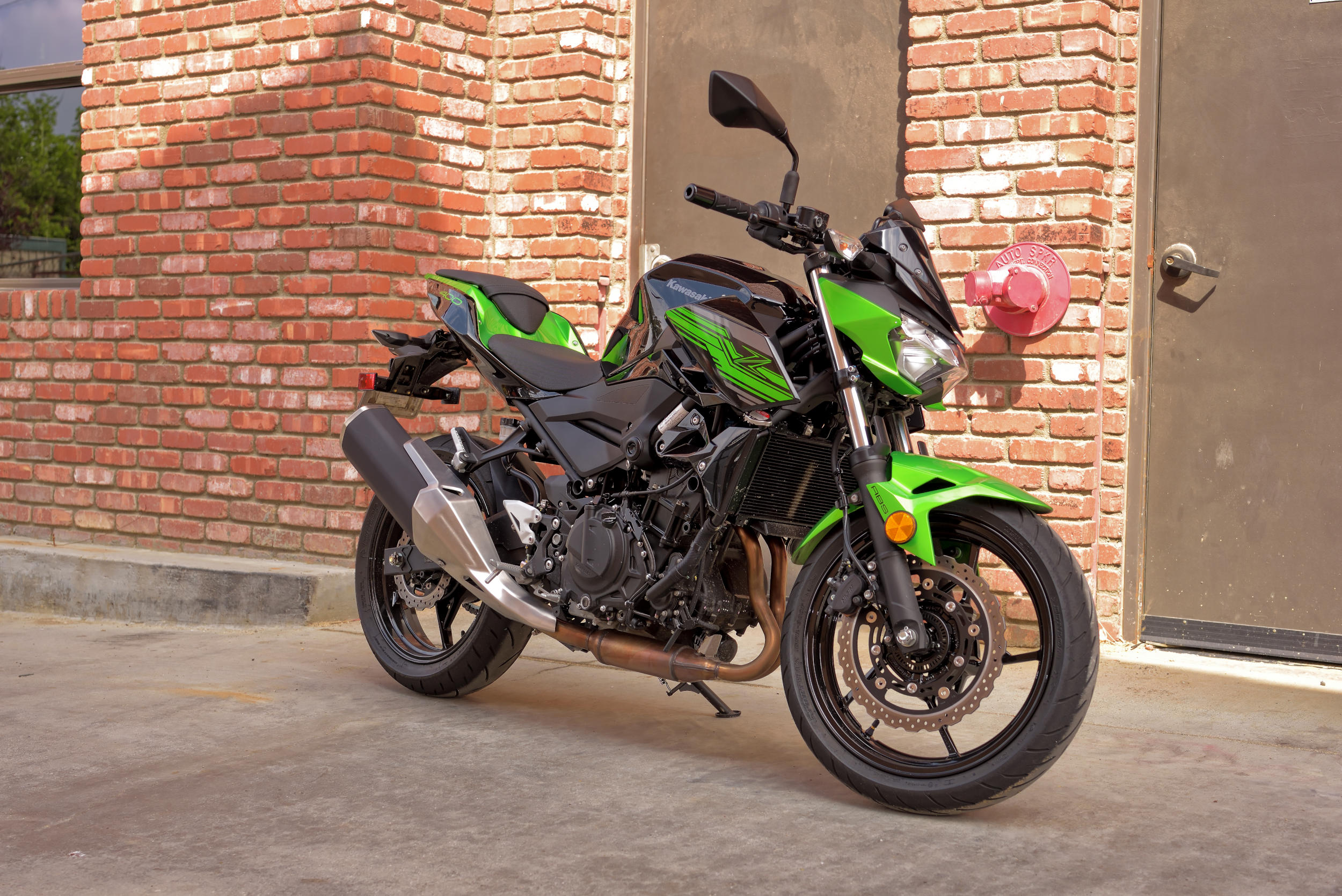
We wanted to perform a longer test, and Kawasaki loaned us the Z400 for several weeks to ride on familiar roads. One of those roads, in particular, confirmed our initial impression of the handling, i.e., that very few production motorcycles can touch a Z400 on a tight, twisty hillside. A fully fueled weight of 364 pounds (with 3.7 gallons in the tank) plays a big role in this. Together with the increase in power and chassis capability, Kawasaki actually reduced the weight versus the previous Ninja 300 models.
Given the bargain price, it is hard to complain about the suspension or the brakes. The suspension lacks adjustment, and is slightly softer than the Ninja 400 sibling, but it generally strikes a good compromise between comfort and performance. With 5.1″ of travel in back, and 4.7″ in front, it absorbs sharp edged bumps (like potholes) better than expected, but not at the level of pricier models equipped with adjustable cartridge forks. As usual, faster riders may want stiffer damping front and rear.
That big 310 mm front brake disc rotor contributes to a braking system with good power and feel for a bike priced under $5,000. Given the light weight of the bike overall, and the low rolling inertia created by the relatively small tire and wheel package, the brakes should prove up to any street task thrown at them, even by aggressive riders. For track day enthusiasts, a simple change in brake lines and brake pad material might keep them happy.

We didn’t have any problems with the six-speed transmission, which provided easy, confident shifts. The clutch requires an extremely light pull – just another reason this bike is so easy to hop aboard and ride. Gear ratios allow relaxed highway cruising together with good acceleration … in large part a result of the torquey power delivery that allows the rider to roll on the throttle at just over 2,000 rpm and achieve a seamless response from the fuel injection mapping.
Although the little Ninja provides good straight-line stability on the highway, it really comes into its own when carving corners (the tighter the better). The wide handlebars and upright seating position don’t hinder the ability to throw the little bike from side-to-side and feedback to the rider from the tire contact patches is excellent.
Of course, high speeds on the highway are accompanied by considerable wind blast on the naked machine, and the seat (as we noted at the press launch) proves a bit too hard on longer rides and tends to push the rider toward the tank. Passing power at elevated speeds, although dramatically improved when compared to the 250s/300s, is still strained when compared to larger displacement bikes.
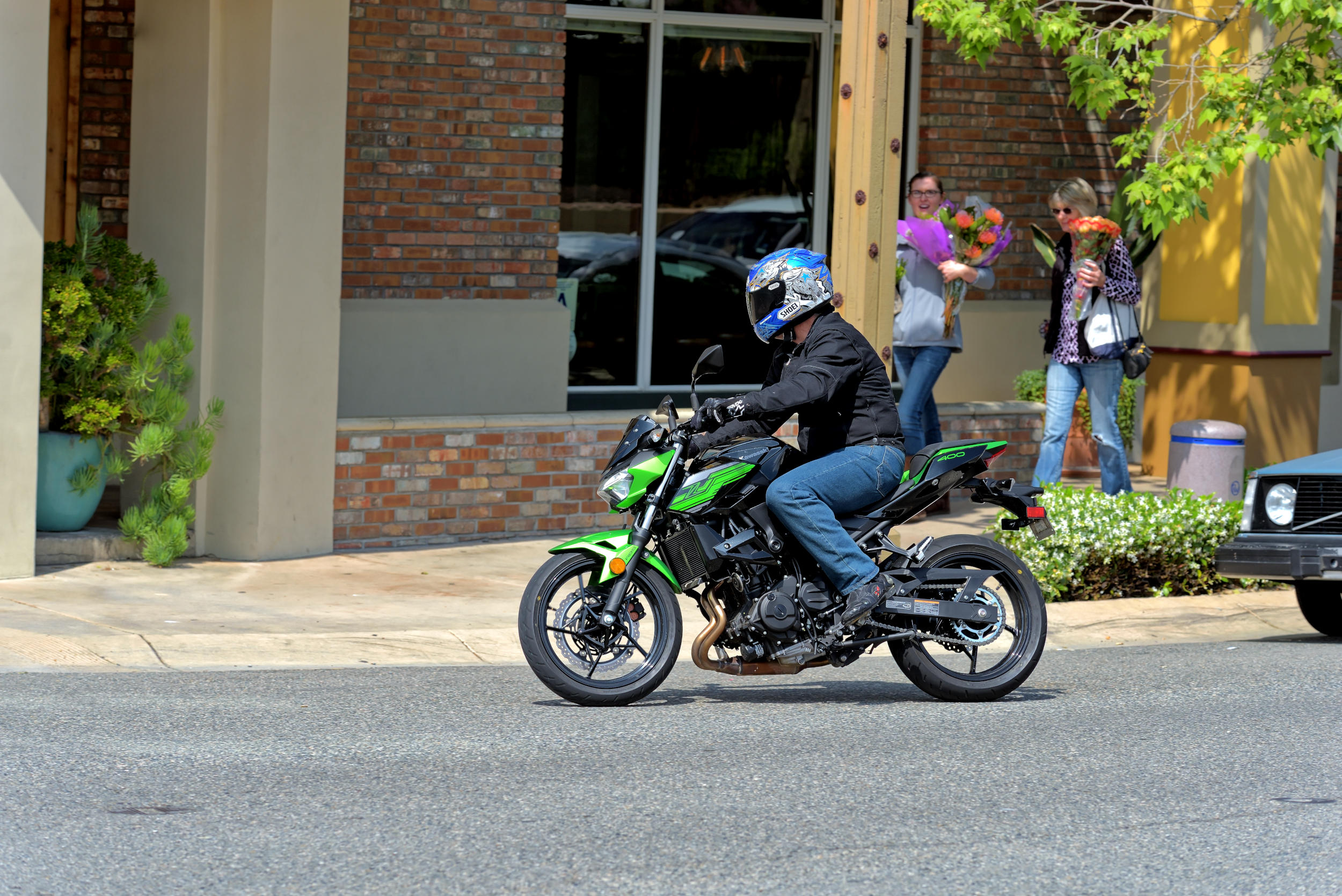
We applaud Kawasaki for equipping the Z400 with LED lights, but even budget bikes need to move to the brighter TFT screen technology, rather than the traditional, relatively dull instrumentation found on the Z400. To be fair, legibility is still good, and the amount of information available, including a gear position indicator, is excellent.
In the end, just like its sibling the Ninja 400, the naked Z400 with its standard ABS brakes and fuel economy in the neighborhood of 60 mpg (easily achievable, even with moderately aggressive riding), represents one of the great bargains currently available in the motorcycle industry. Inexpensive, practical and loads of fun to ride, we can’t recommend the Z400 highly enough. For additional details and specifications, visit Kawasaki’s web site.
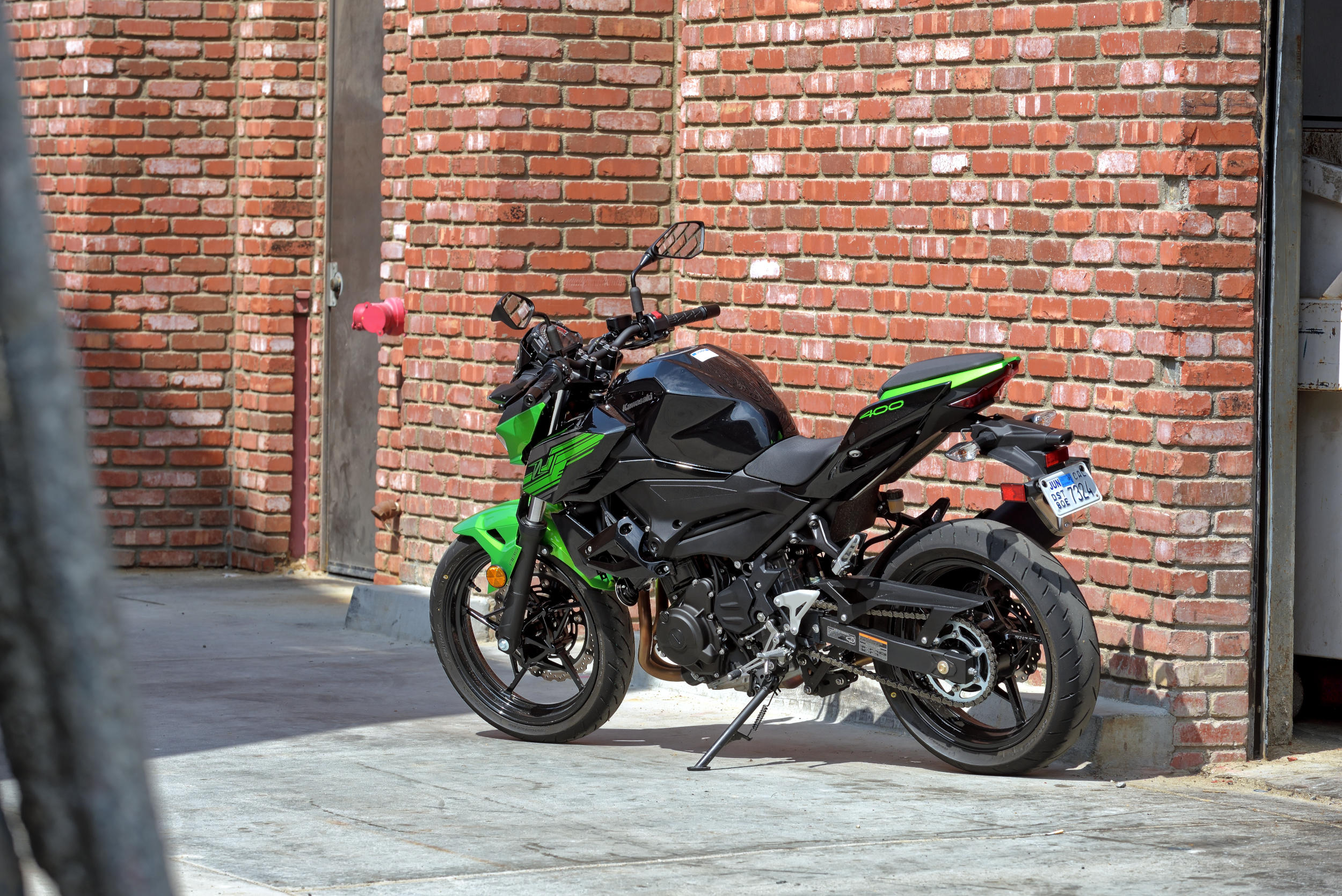
See more of MD’s great photography:

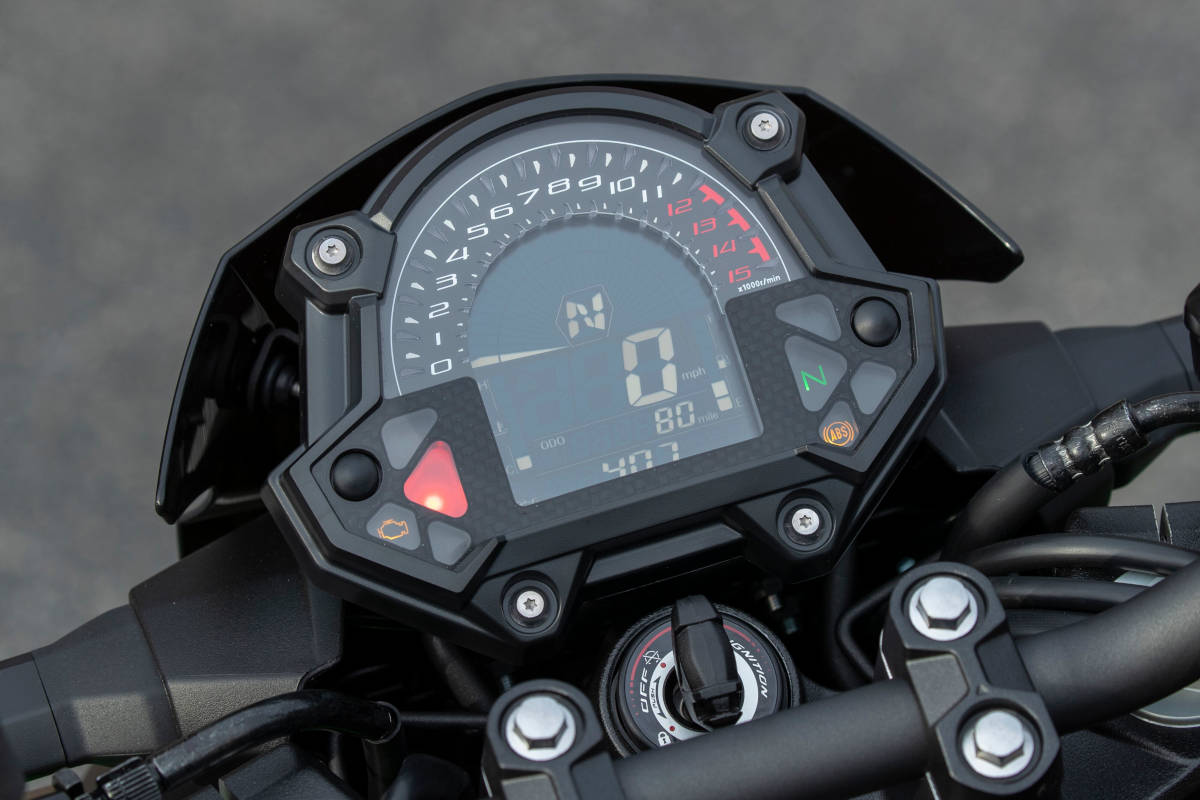





If you haven’t spent a good part of your riding on smaller displacement bike like this Kawi, you aren’t a motorcyclist. Well done Kawasaki.
Nope. That is not the correct definition of a motorcyclist, even though the Z400 seems to be a great bike.
I would agree that smaller displacement bikes like my KLX250S and this 400 are more enjoyable to ride except for touring duty where the big bikes excell. Small cc bikes are just more fun and tend to keep you out of trouble with the law (most of the time.) My Kawasaki has the added benefit of handling dirt trails which opens up a whole new spectrum of riding fun. My next street bike may very well be this 400 as it checks all the boxes that = fun.
Agree with Fred, what cc bike you are riding or have ridden, has no bearing on whether you are a motorcyclist. That’s just silly.
I won’t totally agree, but people who haven’t spent a good part of their riding on smaller displacement bikes usually aren’t as well skilled. Like with many things, you learn and hone your skills on easier equipment. Even MotoGP riders practice and hone their skills on dirt bikes. I’ve seen many riders get the biggest bike they can as soon as they can and that stunts their development as a rider. Besides, light, agile bikes are so much fun, especially in the real world with speed limits. People who don’t ride them don’t know what they are missing out on.
Light, fun bikes like this could extend the riding years for lots of older riders who are leaving the sport because they can’t handle the weight of their heavy cruisers.
TFT LCD is brighter then segmented LCD?
They are not both backlit the same way?
Maybe Kawi just needs to offer the ability to switch to a black characters on grey.
I don’t un see understands why bike designers don’t use translflexive displays that reflect more light making them more legible in direct light.
I’ve never had any problems with analog gauges. I think they are just trying to find the cheapest solution they can.
I have a 2019 Ninja 400 with ABS. The seat is hard. Was hard…. I’m closing in on 3000 miles and now find the seat to be pretty comfortable. I don’t know if the seat has broken in through use, or if my seat has gotten used to it…. 2 hour rides are comfortable even at freeway speeds. I have considered getting the taller seat for a little more leg room, knee comfort…. I’m a little over 6 feet tall fwiw.
I do find the suspension on my Ninja to be a bit soft, so I am a bit surprised that they made it softer for this bike. Probably a nice plush commuter…
Amen on all the comments that a light weight bike, less horsepower bike can be more fun. I have a Suzuki DR 650, and a KTM Duke 690. Living in VA 20 miles from the Blue Ridge Parkway, the DR is the perfect bike for this area and how I ride. Keeping up with friends on 120+ HP sportbikes is not a problem, not due to my riding ability, but just due to the fact that very few people (with a brain) can use more than about 35 HP for more than a few seconds on the street. Additional plus is the old man ergonomics of dual purpose bikes.
Kudos to Kawasaki for making this bike. The Versys version, when it gets here will sell well. Modern version of the European KLE 500.
Everyone should have a DR 650 in their stable. They’re cheap to buy and cheap to keep.
Gary, is your cafe LS 650 from Ryca Motors? Nice bike. Someday I plan to use a DR 650 as a base bike for a similar build.
I started with a RYCA Kit, and then went in my own direction.
https://rycamotors.com/customer_builds/ryca_customer_gcorde.html
Thanks for posting. Nice build. Looks great! The Yamaha “blue spot” caliper(?) is a nice touch!!!
I owned a Savage, the 5% gearing gap between 4th and 5th (while the other gears were widely and nicely spaced), made me think “WTF was Suzuki thinking? Did they just have some gears laying around?” That was my biggest beef with the Savage. A 5th gear that was 15-20% higher than 4th would have been nice.
The Savage is a very underrated bike. Lots of low mileage examples are out there dirt cheap.
That’s beautiful!
Looks great. Thanks for posting. LS 650’s are very underrated bikes. Yamaha “blue spot” caliper is a nice detail. Super detail on the dash.
Probably the best street bike of all time for a person to learn to ride a motorcycle. Light weight, low seat height, heavy flywheel.
That’s a keen eye to pick out the R1 caliper. The bike is a blast to ride and it’s nice to have a bike that’s a head turner – especially when it’s made with your own hands and it’s the one one like it. I think a z400 would complement quite nicely.
Anybody want a FZ6? It too is a custom machine.
Looks great Gary. Thanks for posting.
Nice bike but I think I’d put out the extra cash for the Ninja version. Some of that is for the extra wind protection but probably a bigger factor comes down to looks. The naked version looks a bit cheap; maybe ‘honest’ is a better word? I couldn’t see upgrading the Z model like I could with the Ninja (brake lines/pads, suspension, power).
400cc and 360-370 lbs hits a good target that was slightly missed by some of the 250/300 cc forerunners.
The Z400 uses the exact same seat as the Ninja 400. They both use Kawasaki part number 53066-0619-MA according to KawasakiPartsHouse.com. Thank you, Moat, for pointing out the optional thicker and thinner seats, which fit both versions of the bike.
Maybe the seat feels better to you on the Ninja version because it works better with lower bars, you like the Ninja more, or you expect more seat comfort with a standard or naked style?
Maybe
The Z400 uses the exact same seat as the Ninja 400. They both use Kawasaki part number 53066-0619-MA according to KawasakiPartsHouse.com. Thank you, Moat, for pointing out the optional thicker and thinner seats, which fit both versions of the bike.
Maybe the seat feels better to you on the Ninja version because it works better with lower bars, you like the Ninja more, or you expect more seat comfort with a standard or naked style?
Maybe
It’s funny how tiny these bikes look now. Tiny is great, if your not going far, but this is a big country.
It’s a big country where 80% of the population lives in urban areas.
Looks like some things don’t change much. The seat on my Z750S had the same issue. It was awful. But I got a Corbin, and that did the trick. I’ve modified my Z750S a bit, but now it’s the one bike I wouldn’t give up. I’d even sell my ZX10R first. I would be happy to add another little Ninja to my garage, but I already have three bikes. It must be nice to have a garage like Jay Leno.
Are Corbin seats cheap? No. Are they worth the money? Absolutely. When I buy a new bike, I usually just remove the original seat and get a Corbin.
Hah! I had a Corbin on my Z750S, as well! I bought the bike with it on; I’d never ridden it with the stocker, but by all accounts, it was absolutely awful. Bought one for my Speed Triple T509 before that, too, and it was actually a respectable long-distance bike after that.
It’s not that hard, OEMs! Aprilia nailed it with the Futura. Yamaha is spot-on with the Super Tenere (at least for me). Even Kawasaki had a great seat on the ’90s GPz1100. Sure, no seat will “fit” everyone. But you can at least make one to fit most…
I’d like to see one of these ‘Factory’ Testers explain how they are seemly so different to the rest of the Public.
If they were the same, bikes would be a lot better in so many ways.
Always the hope they will acknowledge in the ‘next’ version they pigheadedly ‘got’ it wrong again.
It must be a continuous yearly plan, so they can again say the magic word ‘improved’.
Maybe it is because these bikes are designed by Asians, who are smaller people, for a predominantly Asian market. In the past I owned a VFR750 and found it terribly difficult and painful to get my hand into the small gap in the frame and between the cylinder banks and turn the adjusting screws to balance the carbs. Probably the guys who designed it didn’t have big hands like me.
In before someone says, “…I’d buy one if ONLY it were a 409/425/450/480/505/550”.
The fact of the matter is, this looks to be a very good choice for those that can actually make up their mind and make a choice. Good work, Dirck.
Along with a Versys version how about a Z400RS? A reborn KZ400 isn’t likely I suppose – though the Versys is probably a no-brainer – but it would get me in the show room at least to look.
If the Versys 300 sold well then the new 400cc version is all but certain to come because part of the reason for re-doing the 300 was that it could not be made to meet Euro4 emissions standards.
The Z400 is the new KZ400. It is a 400cc, parallel twin, UJM. Only the styling has changed. The Z400 would look good next to the 1976 KZ400 in my garage.
The Z400 is on my short list. I’ve owned 5 bikes in the 100-150hp range, and loved them all, but light, agile bikes have a joy all their own. My VTR 250’s are a blast to ride, and the Z400 matches them in weight, but appears to have better ergos, suspension, fuel economy, handling, and brakes.
The Z400 may not be a do-it-all bike, but it looks like a very strong entry in the do-it-fun and do-it-practical categories. As inexpensive as the MSRP is, fixing the seat and adding adjustable levers would probably be early fixes for me. Other stuff might not be needed right away (possibly never), like brake lines, suspension, and tire upgrades.
IMHO, Kawasaki has a winner here.
yep, wouldn’t mind one in my garage. i certainly enjoyed my 09 ninja 650 for 55k miles. the lighter 400 might work for me now. gotta find a dealer who has one in stock.
Fun Bike Center in San Diego says it has one in stock and Vey’s in El Cajon (SD East County) says it has one on the showroom floor. Good luck!
Growing up in the sixties, I doubt entry level buyers today, will appreciate all that this MC has to offer. This would have been considered a superbike back then. The other market for this type of machine, is the older rider, maybe like me, tired of overweight overkill machines, and wanting to relive that small lightweight but technically superior bike. so many bikes, so little time…
I’d really appreciate a Kawa 400 comparison against the current Honda CB500F and CBR500R.
I’ve extensively ridden both the Z400, and the Ninja 400 introduced in 2018. Dirck’s comments about the Z400 having a hard seat that slopes to the front are spot-on. I recommend the Ninja 400 that has all the charms of the Z400 with a much more comfortable seat, and it looks much cooler. There are no Ninja penalties either with the Ninja 400; bars are high and comfortable, and same low end and midrange power as the Z400. Both bikes pull reasonably hard in 6th gear, reminding you of a larger engine. Both are winners. If your dealer has a left over 2018 Ninja 400, snap it up!
I wonder if the accessory taller seat would do the trick (??);
https://www.kawasaki.com/accessories/item/ergo-fit-extended-reach-seat/999941041
What a wonderful little motorcycle – I’m just waiting for a Versys version, which could/would be a perfect lil’ all-rounder, it seems.
I haven’t purchased a new motorcycle since 1984 (a ’81 GN400) but I’m going to buy one of these. My only dilemma is which of the 3 bikes I currently own has to go to make room for this one (I think it’s gonna be the FZ6).
What would be the other two choices?
I have a cafe racer that was built from a LS650 and a scrambler that as built from a DRZ400. The Cafe is perfection…the DRZ looks great but is just OK to ride. The FZ is comfortable, fast and reliable – but as exciting as a toaster.
Then you have chosen wisely.
Gary,
Is your LS 650 made with parts from Ryca Motors? http:/RYCAMOTORS.com
Neat bikes. The LS 650 is a real tractor in terms of low rpm pulling power. The big flywheel would allow the one I had would lug down to about 600 rpm going up a slight hill.